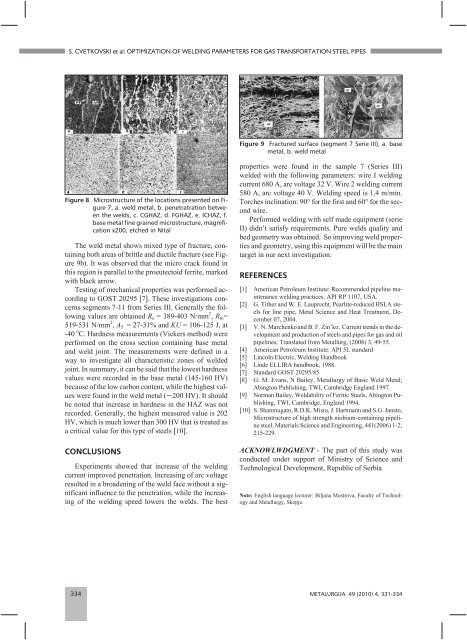PDF - 3756 kB - CARNet
PDF - 3756 kB - CARNet
PDF - 3756 kB - CARNet
Create successful ePaper yourself
Turn your PDF publications into a flip-book with our unique Google optimized e-Paper software.
S. CVETKOVSKI et al: OPTIMIZATION OF WELDING PARAMETERS FOR GAS TRANSPORTATION STEEL PIPES<br />
Figure 8 Microstructure of the locations presented on Figure<br />
7, a. weld metal, b. penetratration between<br />
the welds, c. CGHAZ, d. FGHAZ, e. ICHAZ, f.<br />
base metal fine grained microstructure, magnification<br />
x200, etched in Nital<br />
The weld metal shows mixed type of fracture, containing<br />
both areas of brittle and ductile fracture (see Figure<br />
9b). It was observed that the micro crack found in<br />
this region is parallel to the proeutectoid ferrite, marked<br />
with black arrow.<br />
Testing of mechanical properties was performed according<br />
to GOST 20295 7. These investigations concerns<br />
segments 7-11 from Series III. Generally the following<br />
values are obtained Re = 389-403 N/mm 2 , Rm=<br />
519-531 N/mm 2 , A5 = 27-31% and KU = 106-125 J, at<br />
-40 o C. Hardness measurements (Vickers method) were<br />
performed on the cross section containing base metal<br />
and weld joint. The measurements were defined in a<br />
way to investigate all characteristic zones of welded<br />
joint. In summary, it can be said that the lowest hardness<br />
values were recorded in the base metal (145-160 HV)<br />
because of the low carbon content, while the highest values<br />
were found in the weld metal (200 HV). It should<br />
be noted that increase in hardness in the HAZ was not<br />
recorded. Generally, the highest measured value is 202<br />
HV, which is much lower than 300 HV that is treated as<br />
a critical value for this type of steels 10.<br />
CONCLUSIONS<br />
Experiments showed that increase of the welding<br />
current improved penetration. Increasing of arc voltage<br />
resulted in a broadening of the weld face without a significant<br />
influence to the penetration, while the increasing<br />
of the welding speed lowers the welds. The best<br />
Figure 9 Fractured surface (segment 7 Serie III), a. base<br />
metal, b. weld metal<br />
properties were found in the sample 7 (Series III)<br />
welded with the following parameters: wire I welding<br />
current 680 A, arc voltage 32 V. Wire 2 welding current<br />
580 A, arc voltage 40 V. Welding speed is 1,4 m/min.<br />
Torches inclination: 90° for the first and 60° for the second<br />
wire.<br />
Performed welding with self made equipment (serie<br />
II) didn’t satisfy requirements. Pure welds quality and<br />
bed geometry was obtained. So improving weld properties<br />
and geometry, using this equipment will be the main<br />
target in our next investigation.<br />
REFERENCES<br />
1 American Petroleum Institute: Recommended pipeline maintenance<br />
welding practices. API RP 1107, USA.<br />
2 G. Tither and W. E. Lauprecht, Pearlite-reduced HSLA steels<br />
for line pipe, Metal Science and Heat Treatment, December<br />
07, 2004.<br />
3 V. N. Marchenko and B. F. Zin’ko, Current trends in the development<br />
and production of steels and pipes for gas and oil<br />
pipelines; Translated from Metallurg, (2008) 3, 49-55.<br />
4 American Petroleum Institute: API 5L standard<br />
5 Lincoln Electric, Welding Handbook<br />
6 Linde ELLIRA handbook, 1988.<br />
7 Standard GOST 20295/85<br />
8 G: M: Evans, N Bailey, Metallurgy of Basic Weld Metal;<br />
Abington Publishing, TWI, Cambridge England 1997.<br />
9 Norman Bailey, Weldability of Feritic Steels, Abington Publishing,<br />
TWI, Cambridge, England 1994.<br />
10 S. Shanmugam, R.D.K. Misra, J. Hartmann and S.G. Jansto,<br />
Microstructure of high strength niobium-containing pipeline<br />
steel, Materials Science and Engineering, 441(2006) 1-2,<br />
215-229.<br />
ACKNOWLWDGMENT - The part of this study was<br />
conducted under support of Ministry of Science and<br />
Technological Development, Republic of Serbia<br />
Note: English language lecturer: Biljana Mostrova, Faculty of Technology<br />
and Metallurgy, Skopje.<br />
334 METALURGIJA 49 (2010) 4, 331-334
















